Key takeaways:
- Breakdancing fosters a sense of community, where dancers support each other and build friendships through shared experiences.
- Engagement in local events and groups enhances personal growth and a deeper appreciation for the culture of breakdancing.
- Collaboration during practice sessions allows for skill development and connection, transforming individual stories into a collective narrative through dance.
- Building lasting neighborhood alliances involves genuine interactions, trust, and open communication to nurture supportive relationships within the breakdancing community.
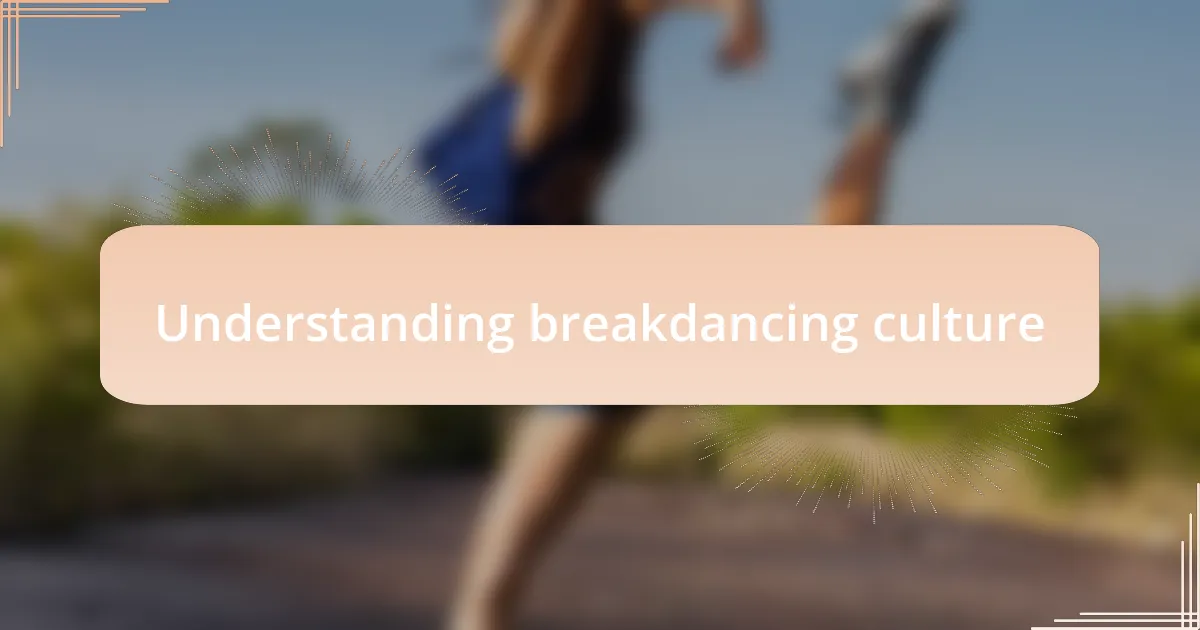
Understanding breakdancing culture
Breakdancing culture is more than just impressive moves and rhythmic beats; it’s a vibrant expression of individuality and community. I remember my first time stepping into a local cypher, surrounded by dancers of all ages. The energy was palpable, igniting my passion and making me feel like I belonged to something bigger than myself. Have you ever experienced that rush of adrenaline, where the music takes over and you just move?
At its core, breakdancing is rooted in creativity and innovation. Each dancer tells their own story through their style and technique. It’s fascinating to see how personal experiences shape one’s dance; a dancer’s background might reflect in their footwork or freezes. I often think about how the struggles and triumphs of life find their way into the grooves, adding layers of meaning to every performance. How can a simple spin or a well-timed freeze convey such depth?
Moreover, breakdancing thrives on collaboration and respect. I’ve seen experienced dancers mentoring newcomers, sharing tips that are not just technical but emotional. This culture of support fosters connections that extend beyond the dance floor. What does it feel like to know that someone is there to uplift you as you stumble through your first steps? It’s a reminder that in breakdancing, just like in life, community is everything.
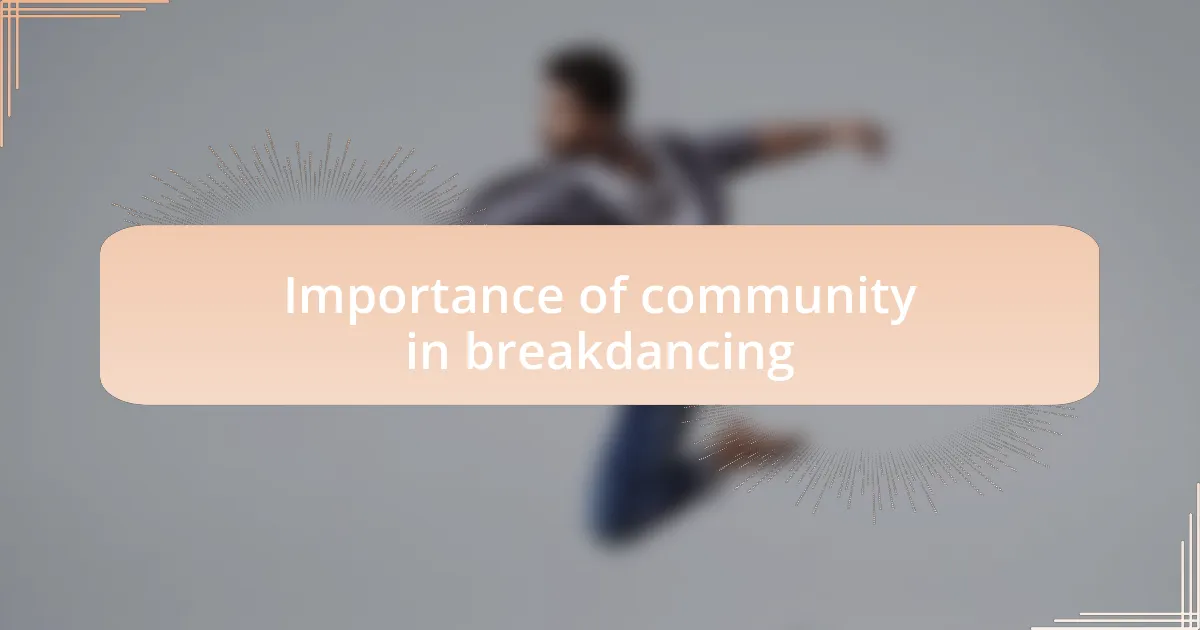
Importance of community in breakdancing
The sense of belonging is essential in breakdancing, as it creates an environment where dancers can thrive. I recall a local jam where I watched seasoned veterans cheering on newbies, and honestly, it was heartwarming. Have you ever felt that rush when someone supports you just at the moment you doubt? That encouragement can make all the difference, pushing dancers to take risks and express themselves.
Community in breakdancing serves as a safety net, where mistakes are seen as stepping stones rather than failures. I remember flubbing a move during a battle and expecting harsh criticism, but instead, fellow dancers clapped and laughed with me. Isn’t it incredible how a united group can turn embarrassment into empowerment? This acceptance enables dancers to explore their limits, free from the fear of judgment.
Moreover, the bonds formed through shared experiences often evolve into lifelong friendships. I once collaborated on a routine with a dancer I barely knew, and by the end, we were exchanging life stories. Isn’t it amazing how the shared passion for breakdancing can transcend into meaningful relationships? Those connections not only enrich our dance journey but also nurture personal growth within the community.
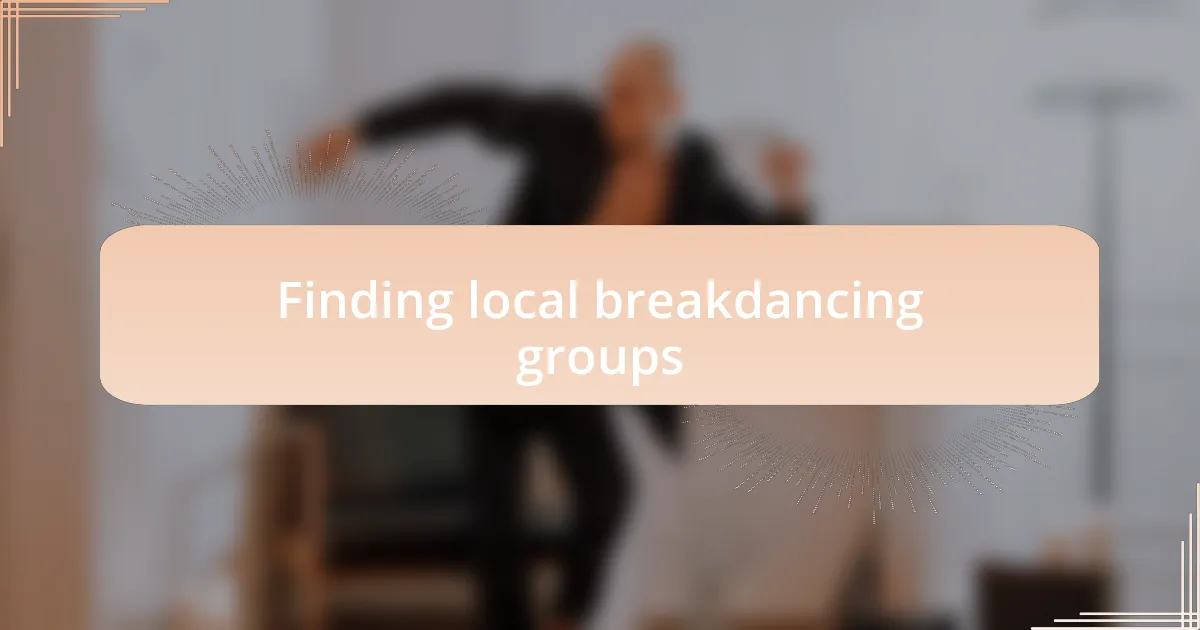
Finding local breakdancing groups
When searching for local breakdancing groups, I found that social media is an invaluable tool. Platforms like Instagram and Facebook often host community pages where dancers share events, tips, and schedules. Have you ever stumbled upon a local cypher through an online post? I know I did, and joining that cypher opened up a whole new world of connections and experiences.
In my journey, I also visited community centers and dance studios, where I discovered flyers and announcements about classes and events specifically tailored for breakdancers. One time, I walked into a vibrant studio and was immediately drawn into an impromptu session. The thrill of being surrounded by enthusiastic learners and seasoned dancers was electrifying. Isn’t it fascinating how sometimes, just being in the right place at the right time can lead to incredible opportunities?
Word of mouth has proven to be equally powerful. I remember chatting with a street performer during a local festival, and they directed me to a jam happening that weekend. That chance encounter changed everything for me—I met not only dancers but mentors who shared invaluable tips. Can you recall a moment when a simple conversation led you to something life-changing? For me, it reinforced the idea that community thrives on connections, both planned and spontaneous.
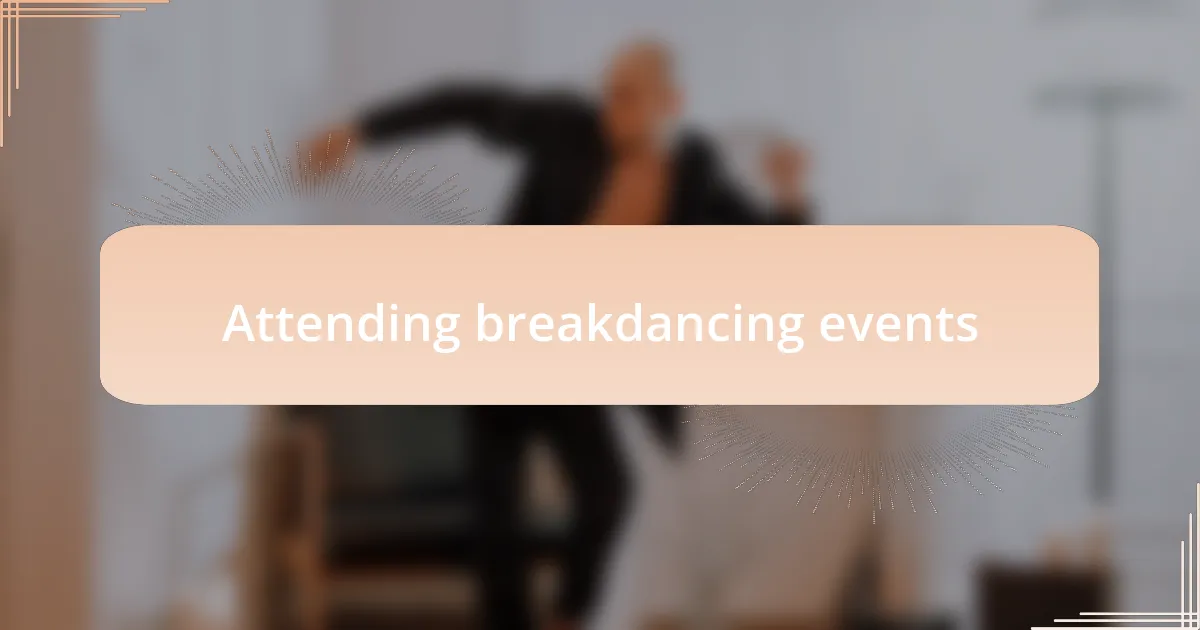
Attending breakdancing events
Attending breakdancing events is like stepping into a vibrant tapestry of rhythm and energy. I vividly recall my first experience at a local battle; the competitive atmosphere was both exhilarating and nerve-wracking. How often do we find ourselves pushed out of our comfort zones? In that moment, every move felt amplified, and I realized that embracing the challenge was part of what makes the breakdancing community so special.
The diverse crowd at these events adds layers of connection that are hard to replicate anywhere else. I remember connecting with a dancer who had traveled from another city just to showcase their skills. We spent hours sharing our backgrounds and passion for the art form. There was something incredibly grounding about knowing that no matter where we come from, the love for breakdancing binds us together. Have you ever met someone who instantly understood your passion? That moment solidified my sense of belonging in this thriving community.
As I navigated through these events, I found that each one offered a unique lesson. I once attended a workshop led by a seasoned b-boy, where I learned more than just advanced footwork—I learned about the history and culture behind the moves. It made me appreciate the depth of what I was practicing. Have you thought about how much richer our experiences become when we dive deep into a community’s roots? Events like these remind me that breakdancing is not just about the dance; it’s a living, breathing expression of creativity and connection.
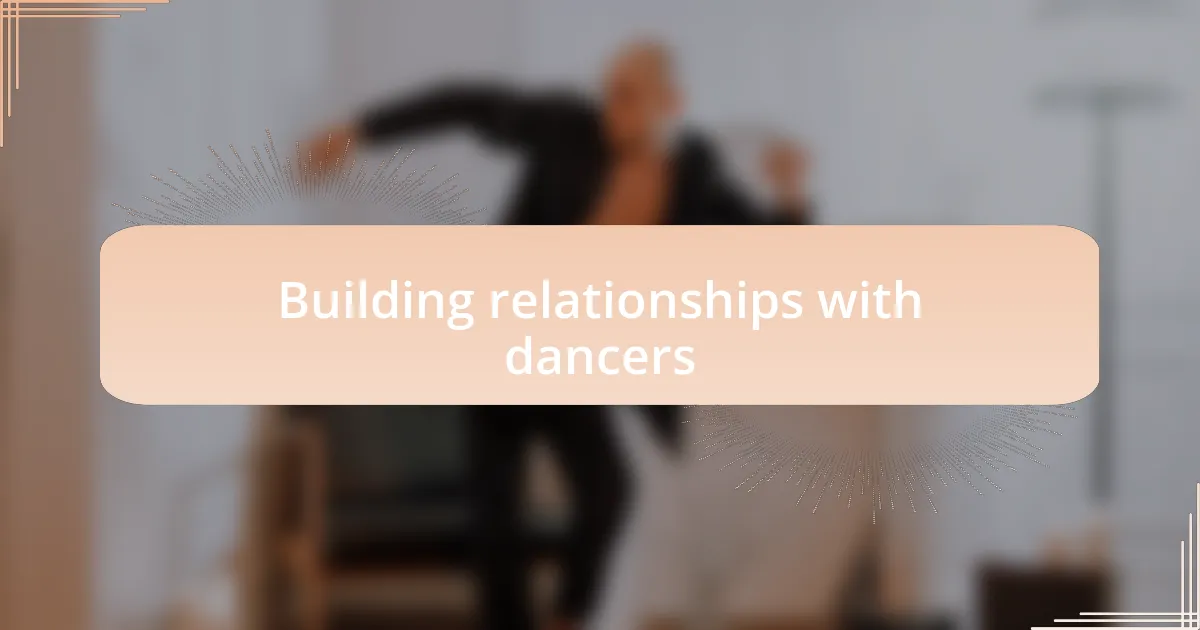
Building relationships with dancers
Building relationships with dancers is a deeply rewarding journey that often starts with a shared passion. I remember striking up a conversation with a fellow dancer during a jam session, and as we exchanged tips and tricks, I felt the walls of competition dissolve. Have you ever had that spark of camaraderie where it feels like you’re not just sharing moves but also dreams? It’s those moments that create lasting bonds.
When I started attending regular practice sessions with a local crew, I discovered that the relationships formed on the dance floor extended far beyond just breaking. The laughter, the encouragement during tough routines, and even the shared frustrations over mastering a new move all contributed to a sense of family. I often look back at those times and realize that building trust and respect among dancers creates a supportive environment where everyone can thrive.
Sometimes it’s the simple act of cheering each other on that strengthens these connections. I distinctly remember a recent competition where I wasn’t competing, but rather there to support friends. Their energy was infectious, and standing there, watching them pour their hearts out, made me appreciate what it means to be part of a community. Don’t you think experiencing those highs and lows with others amplifies both the joy and the growth we feel in our craft?
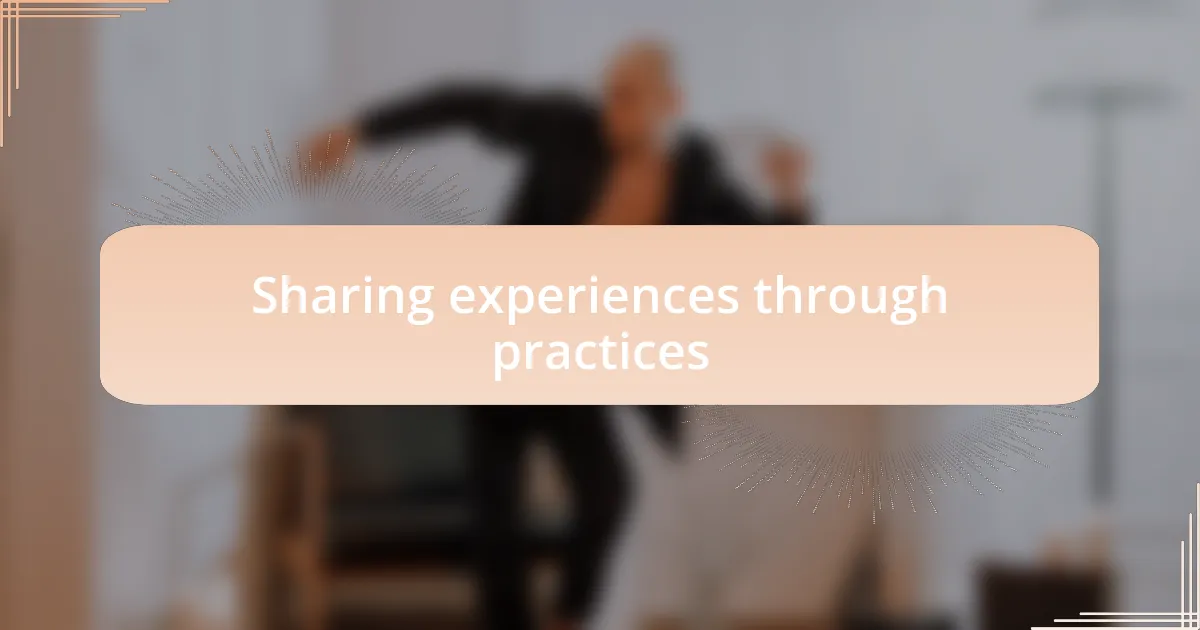
Sharing experiences through practices
Sharing experiences through practices truly transforms the way we connect. I remember one evening when we decided to have a themed practice session focused on experimental movements. As we each contributed our unique styles, I noticed how everyone felt encouraged to step outside their comfort zones. Isn’t it interesting how a simple idea can lead to profound learning moments that deepen our bonds?
In my own journey, I often find that the most meaningful insights emerge during casual practice sessions. I recall a time when a newer dancer struggled with a particular freeze. Instead of just offering advice, I showed them my approach while learning in real-time, which turned into a collaborative exploration of technique. This exchange not only helped them but also reminded me of the joy of rediscovering basics. Don’t you find that sharing knowledge in this way enhances our connection to each other?
What resonates most with me is how these shared practices create a collective memory. I once participated in a community workshop that focused on storytelling through dance. Each dancer shared personal experiences and then translated those stories into movement. It was incredibly emotional to witness everyone’s journey come alive through their styles. How often do we get to see our individual narratives interwoven into a greater tapestry? It’s in those moments that the dance floor transforms into a canvas of our shared experience, where we truly learn from one another.
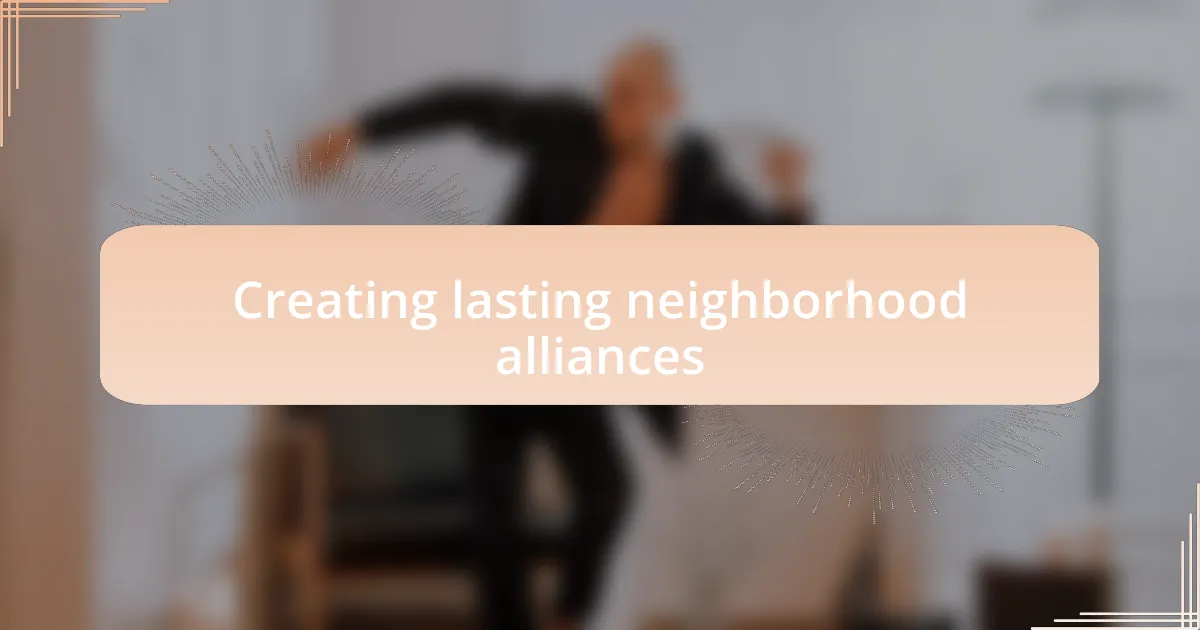
Creating lasting neighborhood alliances
Building lasting neighborhood alliances requires more than just sharing a love for breakdancing; it demands genuine connection. I remember one day walking through my neighborhood, where I noticed a group of dancers gathered at a local park. Instead of walking past, I decided to join in and introduce myself. That simple decision turned into an unforgettable afternoon of movement and laughter, strengthening ties that would eventually lead to collaborative events. How often do we overlook opportunities to connect simply because we hesitate to step forward?
One of the most rewarding aspects of creating these alliances is witnessing how they evolve over time. I think back to a block party we organized, driven by our shared passion for dance. Initially, it was just a small gathering, but as the day unfolded, friendships blossomed. We ended up forming an impromptu performance group, showcasing styles from various backgrounds. Isn’t it incredible how the spark of collaboration can ignite deeper relationships, allowing us to support one another both on and off the dance floor?
Trust and open communication are the cornerstones of any successful alliance. Reflecting on my experience, I’ve found that checking in with fellow dancers after practices builds a sense of community. Once, after a particularly challenging session, I sent out a message to everyone asking how they felt about the techniques we tried. The responses were filled with encouragement and suggestions, deepening our understanding of each other’s perspectives. When we actively engage in these conversations, aren’t we essentially weaving a stronger fabric of support around us?